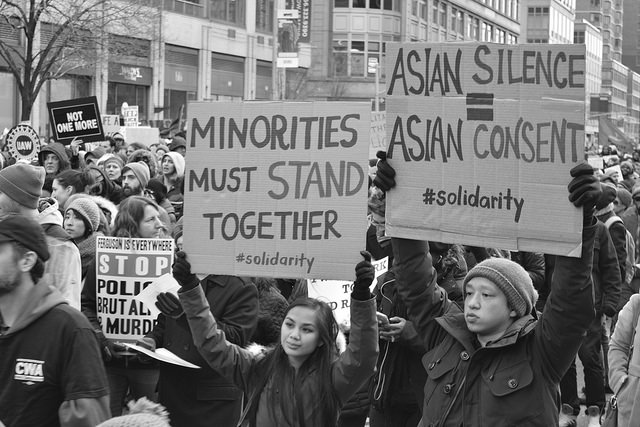The year since Trump was elected has been an important year to be an Asian-American or Pacific Islander.
It’s been a frustrating year.
It’s been an inspiring year.
At times it’s been a frightening year.
But right now, in our history as Americans, immigrants, and Dreamers, being AAPI matters.
When Trump was elected many of us held our breaths. Here was a president-elect who was blatantly xenophobic, one who did not see Americans, but saw “us” and “them”. In his rhetoric, behavior, and rallies he stoked a culture that had always equated brown skin as a threat, and encouraged racists to come into the light – to shout louder, hit harder.
For the AAPI community, our time in America includes large swaths where we were (or are) seen as the unassimilable “other”. We’ve been banned, rounded up, imprisoned, and deported en masse, all within the last 150 years in America. For many of us, that part of our history was largely forgotten, replaced with a “model minority” or obedient worker stereotype.
But during the 2016 election, and in the months since, we’ve been reminded. History is threatening to repeat itself and we are saying “No.”
In the face of the Trump presidency and his supporters, the AAPI community is more united than ever. With language used to discuss the Muslim ban practically identical to the rhetoric used during the Chinese Exclusion Act or the World War II Japanese Internment, AAPI voters are overwhelmingly identifying as Democrats. Whereas previously Asian-Americans were considered swing votes with a conservative leaning, this last election found 79 percent of AAPI voters voting for Hillary Clinton.
With over 77 percent of young AAPI voters preferring the Democratic party now, versus 20 years ago when the GOP was favored, many name immigration issues, “exclusionary rhetoric”, and gun control as major reasons why they are switching parties.
While the entire AAPI community may not always be harmonious – discord amongst different immigrant groups is an ongoing struggle, especially concerning the “right” or “wrong” way to immigrate – support against Trump crossed racial and cultural lines. Whether it’s banning Muslims or the “model minority” moniker, many Asian-Americans must consider, maybe for the first time in their young lives, that America has a tendency to create stereotypes for its perceived benefit.
Muslims are bad, Chinese or Japanese “model minorities” are good – both are dangerous, damaging, and serve to divide immigrants and minorities on racial lines in order to bolster white American control and superiority. It’s insidious. But while Trump’s blustery, bullish, fear-fueled manner inspired his supporters to rise up, he also managed to inspire minorities to fight back.
Federal Judge Derrick K. Watson from Hawaii (just some “island in the pacific”), has stopped Trump’s travel ban three times. It’s no coincidence that a Native Hawaiian judge in a minority majority state is taking the lead in the fight against Trump’s racism.
With the majority of Hawaii residents being of Asian, Pacific Islander, or Native Hawaiian descent, the travel ban seems almost a direct attack on the people of Hawaii. Hawaii residents and their ancestors either immigrated to America – perhaps at a time when American didn’t want “their kind” – or had America thrust upon them. Either way, Hawaii is a state of “others” to many Americans.
In defense of many “others” who want to come to America, need refuge in America, or those whose voice Trump America deems a threat or inconsequential, it seems only right that AAPIs say, “No, not again.” Hawaii led, and continues to be a leader in that fight.
There’s an urgency to speaking up now. With an uptick in violence against Asian-Americans since Trump was elected, the community can no longer afford to further any stereotype of being “polite” or “timid”. If Trump supporters feel empowered to scream “Go back to China!” or whatever garbage they see as the blanket thing that encompasses all “Asians”, then the AAPI community has to scream back. For many this is an uncomfortable transition, but it has also created greater sense of strength as a minority group.
Asian-Americans are now far more likely to report hate crimes, either to the police or to the media. While the numbers are still low in some rather insular immigrant communities where English is not comfortably spoken, Asian-Americans in suburban or metropolitan areas are becoming more forthcoming.
And they are getting support. From other AAPIs, from the non-Asian community, from white Americans. By speaking up, the AAPI community is raising awareness that anti-Asian sentiment is still very real in 2017 America.
In January of this year, Asian Americans Advancing Justice launched standagainsthatred.org, a website devoted to reporting hate crimes against Asian-Americans and Pacific Islanders. The site not only gives the AAJC a way to track hate crimes, but also gives legitimacy to claims. When you read the stories, see the dates on them, see the regularity with which such things happen, it makes it real. Not hearsay concerning nameless “others”, but a reality in American culture.
Asian-Americans and Pacific Islander voices are getting stronger, more obstinate in the face of racism. We are unwilling to watch history repeat itself, whether it’s against us or those who are being treated like we were just decades ago. Despite what America has told us for so long, we do have a loud, relevant voice. There are too many of us to ignore, we just needed to come together.
Sadly, that reason was Trump.
Photo: Marcela/Creative Commons

